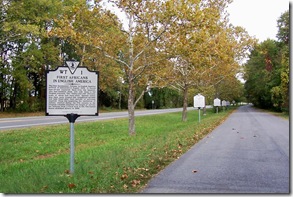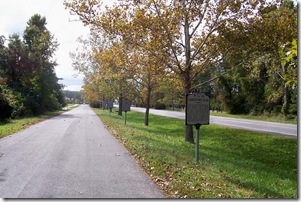 Marker No. WT-1
Marker No. WT-1
James City County, VA
Marker Text: The first documented Africans in English America arrived at Jamestown in August 1619. A Dutch man-of-war captured them from the Spanish, who had enslaved them, and sold them to the Virginia colonists. The "twenty and odd" Africans, some of whom had been given Spanish names, may have been treated like indentured servants and later freed after their periods of servitude expired. From this beginning the institution of slavery evolved during the 17th century as the Virginia colonists extended the length of service for Africans from a fixed term to life. The United States abolished slavery in 1865.
Location: Marker is grouped with five other markers on Frontage Road paralleling Route 31 (Jamestown Road), 0.2 miles north of Route 359. The markers are north of the northern terminal for the Jamestown Ferry crossing the James River. Erected by the Department of Historic Resources in 1992.
 Photo taken looking north, Frontage Road on right and Route 31 on left. Four other markers can be seen in the distance. Click any photo to enlarge.
Photo taken looking north, Frontage Road on right and Route 31 on left. Four other markers can be seen in the distance. Click any photo to enlarge.
This month is African-American History month and I will share some markers related to this month long observance. This marker actually commemorates a tragic day in the history of African-Americans when about 20 African-Americans arrived in the colonies and millions more who would follow, to be enslaved in the English Colonies and the United States during the next 247 years. In 1619, the first Africans were brought to Jamestown under what was presumed to have been indentured servitude. (An indentured servant would be required to work a set amount of time, then granted freedom.) Over the next few decades this would change to the enslavement of black Africans occurring one law at a time and one colony at a time.
In April of 1619, the Governor of the Jamestown colony, Sir George Yeardley, sent an English ship named the Treasurer and a Dutch “Man of War” ship on a supposed "routine trading voyage." The Treasurer's true purpose was to act as a privateer and raid Spanish shipping and the Dutch ship was intended to cover their activities. While in the West Indies, the two heavily armed vessels captured a Portuguese merchant-slaver ship named the San Juan Bautista. Included in their plunder were approximately 100 Africans. The Dutch ship returned at the end of August of 1619 to Old Point Comfort (near Jamestown) with approximately 20 of the Africans. The Dutch sold most of the Africans to Governor Sir George Yeardley and the colony's wealthiest resident, a merchant named Abraham Peirsey.
The Portuguese had considered the Africans to be slaves. However, because slavery had been eliminated as a classification in English law in 1619, they needed most likely to be legally classified as "indentured servants." Ironically, the first English Colony in North America to legalize the enslavement of black Africans was Massachusetts in 1641. Soon laws were passed to legalize slavery in the other English Colonies.
Photo taken looking south on Frontage Road toward the James River, today’s marker is the third marker in the distance.
In 1662 Virginia legalized the enslavement of black Africans. All children born to enslaved mothers were the property of the slave mother's owner. The condition of enslavement was passed down from generation to generation. In 1705, Virginia declared that "All servants imported and brought in this County... who were not Christians in their Native Country... shall be slaves. Negroes, mulattoes and Indian shall be held to be real estate."
Traditionally, Englishmen had held the belief they had the right to enslave non-Christians or captives taken in a just war. Conveniently Africans and Native American fit this definition. But what if these captives learned to speak English and converted to Christianity would they be released from bondage and given their freedom? Instead the status of Africans were not later determined by changing their religious faith, but by their unchangeable skin color.
In school we were all taught the story of the Pilgrims who landed on Plymouth Rock in late autumn of 1620 and their ship, the Mayflower. While little is known or taught about the first African-Americans who arrived involuntarily in the Jamestown Colony in 1619, more than a year before the arrival of the Mayflower in America. Jamestown, which was established in 1607, was the first permanent English Colony in North America. The arrival of approximately twenty Africans in 1619 marks the official beginning of slavery in what would become the United States of America.
Based on a census taken in March of 1619, there were already thirty-two African-Americans (15 men and 17 women) "in the service" of Jamestown planters prior to the August arrival of the Dutch ship. The difference between these two groups is that the early group were there voluntarily in the colonies, in order, to receive land grants and establish a life for themselves in the new colonies, like many of the white settlers who had come to the colony and many did later own land and start businesses.
There are indications that, after years of servitude, some of the twenty stolen Africans brought to Jamestown in 1619 eventually did obtain their freedom. However, unlike most white indentured servants who voluntarily contracted their services for a specific period of time, these Africans were not given such options and most of them probably remained in servitude for the rest of their lives. Indeed, by 1625, the Jamestown census listed ten "slaves." Over the next decades, the number of African slaves in the colonies would increase by the thousands.

No comments:
Post a Comment